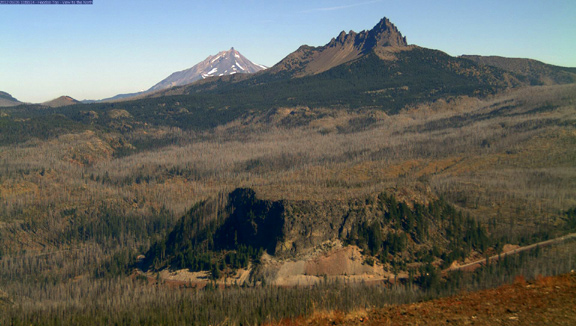

SNOW CAMPING
It was midnight. The wind buffeted the tent worse now that I had
pushed off the new snow that had accumulated on the canopy. Banging
my hands on the canopy from inside the tent had caused most of
it to slide off. I knew it was damn cold outside but my sleeping
bag was thick and I snuggled back inside, only to be roused an
hour later by a nagging urge to poop. My breath came out in big
clouds. This was bad bad news and ill-timed to say the least.
I felt grumpy. I mumbled something colorful. 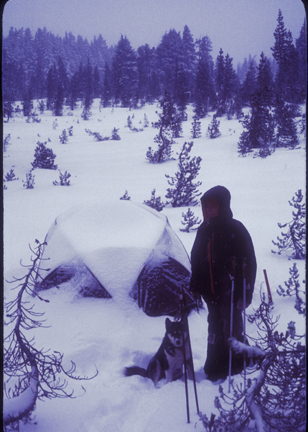 After
trying to ignore the urges for another hour, I knew I had to use
my secret weapon. Sliding out of my sleeping bag, I pushed it
and my pad aside to expose the tent's cook hole. Zipping it open
exposed a deep hole in the snow that I had dug before setting
up the tent. It was my emergency cat hole-- Now I zipped the door
of the tent partially open to expose my thermometer hanging there,
reading 4° above zero. The wind was blowing and I shivered
at the very thought of being outside in the powdery snow with
my pants pulled down. Inside the tent, well away from the walls,
I carefully lit my camp stove, making sure I had plenty of ventilation.
The tent warmed rapidly and soon I was pulling my pants down and
positioning myself above the snowy hole. Oops, I had forgotten
my baby wipes, but a long reach retrieved them. Then it was just
a matter of letting loose and cleaning up before zipping the cook
hole closed and turning off the stove. In the morning when breaking
camp it would now be a simple chore to scoop up the frozen poop
and "tp" into an appropriate bag and pack it out with
me...Picture: near Mt. Bachelor, Oregon. It was a measured zero
degrees, which didn't seem to bother my little Siberian Husky
Kaila. The tent was the North Face Oval Intention, an early "Ring
Oval" model. Strong as snot, a true geodesic. It was introduced
in very late 1975
After
trying to ignore the urges for another hour, I knew I had to use
my secret weapon. Sliding out of my sleeping bag, I pushed it
and my pad aside to expose the tent's cook hole. Zipping it open
exposed a deep hole in the snow that I had dug before setting
up the tent. It was my emergency cat hole-- Now I zipped the door
of the tent partially open to expose my thermometer hanging there,
reading 4° above zero. The wind was blowing and I shivered
at the very thought of being outside in the powdery snow with
my pants pulled down. Inside the tent, well away from the walls,
I carefully lit my camp stove, making sure I had plenty of ventilation.
The tent warmed rapidly and soon I was pulling my pants down and
positioning myself above the snowy hole. Oops, I had forgotten
my baby wipes, but a long reach retrieved them. Then it was just
a matter of letting loose and cleaning up before zipping the cook
hole closed and turning off the stove. In the morning when breaking
camp it would now be a simple chore to scoop up the frozen poop
and "tp" into an appropriate bag and pack it out with
me...Picture: near Mt. Bachelor, Oregon. It was a measured zero
degrees, which didn't seem to bother my little Siberian Husky
Kaila. The tent was the North Face Oval Intention, an early "Ring
Oval" model. Strong as snot, a true geodesic. It was introduced
in very late 1975
You might wonder where I'd learned this (some would say) disgusting wilderness camping trick. It wasn't discussed in the bible of the sport, "Mountaineering The Freedom of the Hills." In my gear catalogs I had noticed that some tents had cookholes and many did not. The ones that did tended to be expedition tents made for climbers who could get hit by blizzards and trapped in their tents for days at a time. Cooking outside under conditions of high wind, serious cold and falling snows could be well-nigh impossible, as would the critical task of melting snow to prevent dehydration and mountain sickness. So cookholes made good sense. But what about pooping? I had noticed that after a couple days confinement, my waste liquids like hot soup poured into the cookhole had melted a deep hole in the snow. One time I had been bursting and had guiltily peeded into the hole. You can guess the rest. Maybe I can blame the altitude and isolation for muddling up my mind and destroying my values, but once discovered, I held onto the technique, my own dirty little snow-camping secret. Years later, it occurred to me that perhaps hardcore climbers had always known that "cook holes" were just aphorisms for "poop holes." NASA wasn't afraid of addressing the issue of pee and poop inside confined spaces, why should I be afraid or ashamed? (see below)
Selecting your poop hole
tent:
It needs a factory cooking hole. The tent should be high enough
to crouch over comfortably over the cooking hole. The hole should
preferably be more or less in the center of the tent, as in this
classic, much-beloved Sierra Designs 3-man (teepee) tent (picture).
Note the cookhole placed close to the center of the Sierra Designs
tent, with lots of headroom. The next picture shows a Holubar
Expedition tent, which has a cookhole. The red dots talk about
its 38" long cookhole zipper. (pictures coming soon)
The third picture shows a Snowlion Triplex winter tent, made by an innovative Bay Area company during the 70s. It gave the user two cookholes, placed in its two vestibules. It was a very cool-looking tent!
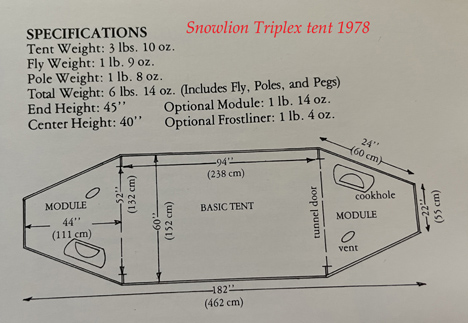
But for my money, the best cookhole placement is in the Sierra Designs tent (see picture of the blue/gray tent near page bottom)
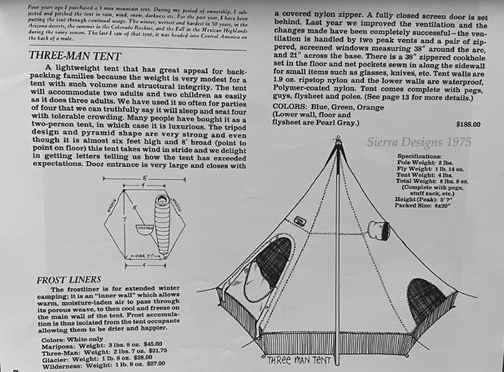
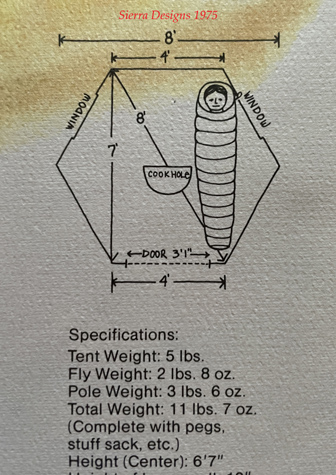
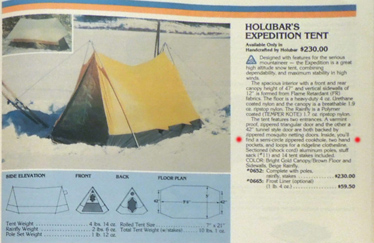 workmanship
was awesome
workmanship
was awesome
The Bible of my sport, "Mountaineering The Freedom of the Hills," did not mention any such solution to the problem of human waste in the winter wilderness.... you won't find it in any guidebook. But if you are out in the winter wilderness for long, you will need to deal with this, like it or not.
Also, tips for tent campers in general must
include what to do about dogs that can't seem to see mosquito
netting and try to walk right through the netting, doing damage
that's difficult to repair. .
Critters that want to chew their way into your tent searching
for food or salty things, and worse than food, like to chew up
your leather mountain boots for the salt.
Please Note: All Material below, and in all my "History of Gear" webpages, is copyrighted, and no usage of my material is permitted unless explicit permission is granted by me, Bruce B. Johnson, owner of OregonPhotos.com. Editors: Please contact me at brucej@oregonphotos.com if you have interest in publishing....Others: if you were involved with one of the old-line, vintage gear companies and have a story to tell in these pages, please contact me soon.
In 1975 I owned one of these
made with orange ripstop  **********************************************************************************************************************************************
**********************************************************************************************************************************************
First in the series was a volume about Frostline Kits of Colorado, completed with considerable help with the company founder, Mr. Dale Johnson. Next came "GERRY, To Live in the Mountains," 78 pages, 10x8 inches, full-color, released May 20, 2008; this book also benefited from considerable help from its company founder, Mr. Gerry Cunningham. And there are other books; for a complete look at the ten titles I have created, click here.
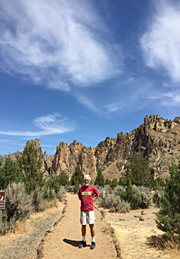 Smith
Rocks
Smith
Rocks